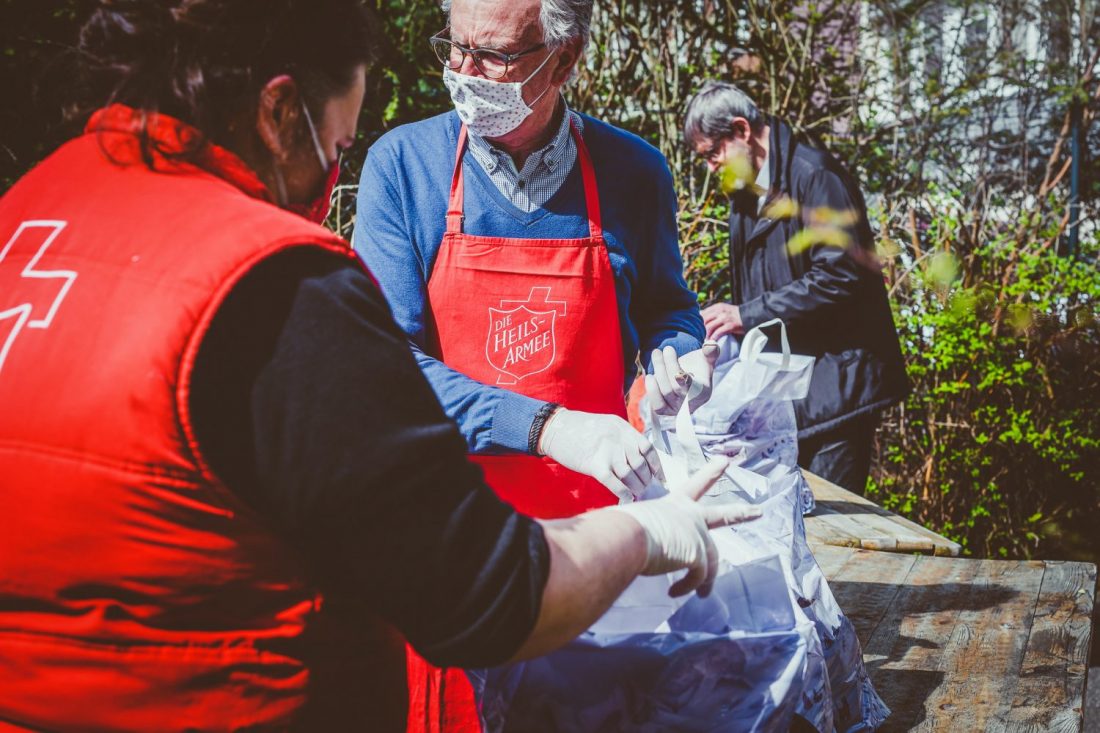IHQ releases new resource to unite Salvationists
 Released in November 2014, One Army is used as an international teaching guide on the nature and purpose of The Salvation Army in more than 20 languages.
Released in November 2014, One Army is used as an international teaching guide on the nature and purpose of The Salvation Army in more than 20 languages.
“This resource is designed to unite Salvationists worldwide and help them and others understand its mission and message in clear global terms,” said author Commissioner Robert Street about the original series. “It covers what the Army is called to be, what it should be and how it expresses itself as part of the universal church.”
Street said “In The Master’s Hands”—a book with an accompanying DVD—“sets out in clear, easily understandable terms, The Salvation Army’s emphasis on each life being sacramental. Whatever form our worship may take, the inner relationship with Christ must always be the foundation for each Christian life, and for our relationship with each other.”
The work aims to put concerns over ecclesiastical structure and authority into context with the reminder that there is only one Church.
A section on “The Body of Christ” reads: “There is only one Church—just one. Christians call it the Body of Christ. There can be only one. It is not a human invention, nor is it dependent upon any ecclesiastical structure. It is of the Spirit; invisible, unseen. It comprises all who confess Jesus Christ as Savior, who welcome him as Lord of their life, and are thus united in the Holy Spirit. That unity is emphasized by the apostle Paul in his First Letter to the Corinthians (12: 12-13), where we read: The body is a unit, though it is made up of many parts; and though all its parts are many, they form one body. So it is with Christ. For we were all baptized by one Spirit into one body—whether Jews or Greeks, slave or free—and we were all given the one Spirit to drink.”
At its heart, the book invites readers to place their lives in God’s hands and then discover it is the best thing they could ever have done, Street said.
A youth edition, written by Major Nick Coke, will soon be published.
See more at salvationarmy.org/onearmy.
A review
By Philip Davisson, Major –
The title of this new resource, “In the Master’s Hands” from International Headquarters, suggests not simply its subject matter, but also its approach. The slim volume of 20 readings makes a clear reference to the broader subject of sacraments only in the subtitle. It leads off instead with a phrase taken from a line of a General Albert Orsborn song, “My all is in the Master’s hands….” And this phrase is from the central stanza of that three-verse song, not the first. Structurally, the approach signals an aim for the center, the essence, the heart of the matter, rather than striking head-on at a question which has been a matter of long-standing doubt and dispute.
Much of the last century of Salvationist writing about sacramental practices has been from a defensive posture. Various booklets have been written to explain why a Salvation Army meeting does not include a bread-and-wine (or grape juice) ceremony service, or why Salvation Army soldiers are not enrolled following some form of water baptism. In these earlier works, biblical passages have been probed, drawing out deeper spiritual realities behind traditional churchly practices. Parallels to these from Salvationist sensibilities have been lifted up to demonstrate faithfulness to biblical mandates for all Christians.
The defensive posture began to change with the publication over 20 years ago, during the time of General Paul Rader (Ret.), and the release of conclusions from the International Spiritual Life Commission’s review of the Army’s non-ritual sacramental practice in a pamphlet, “Move Forward In Freedom.” Salvationists were encouraged to discover creative contemporary ways of celebrating Christ’s living, active presence in our midst as communing bodies, both in worship and in service, in mission and ministry. Bringing a measure of clarity to apparent prevailing prohibitions to participating in other churches’ ceremonies, Salvationists were to now feel free to seek meaningful connections to sacramental actions and permitted to participate in open communion moments with Christian neighbors, all the while refraining from establishing prescribed rituals relating to sacramental rites in their own meetings.
Yet there has remained a persistent uneasiness in Salvationist circles in various parts of the world. This latest approach is a penetrating foray into positive presentations of Salvationist sacramental theology. While in the past many have wondered if, within the circumscribed set of traditional church sacramental rites, Salvationists had shrunken sacraments to invisibility, the reality has always been Salvationist sacramental sensibilities had been expanded beyond the borders of the circle. It is not that Salvationists do nothing of a sacramental nature, but that all of life is sacramental.
Thus the subtitle of this new booklet, “Each Life Sacramental,” and the main title’s connection to the Orsborn song. The aim is for the center, the essential meaning and purpose for being a God person through Jesus Christ. The beginning pages of the new resource probe the essential questions of Christian identity. What makes a person a Christian, by what means is this accomplished? It is a conversion process, an intentional and purposeful releasing of your own way of moving through life and turning toward the Jesus way. It is a commitment of your self—an active trust—into the saving care and guiding agenda of the God revealed by various means: by holy, sacred avenues making possible God’s gracious presence available to those otherwise blinded to this reality. Sacraments are formalized ritual moments which can make this happen, they can be windows onto grace, which is God’s powerfully transformative presence.
Salvationists have long urged an understanding of the whole spectrum of grace in our lives, from long before the salvation commitment of initially placing yourself into the master’s hands, and then the journey of Christian growth and discipleship made up of the progressive commitments intensifying your trust in God’s hands, the way of becoming more and more holy like Jesus. The days along the way are filled with less formal non-ritualized God-grace moments, times where the mask of superficially less-sacred life fades and the ever-present realm of God is suddenly more real.
Often these moments come into being through times of genuine human contact, which is also how God’s sustaining provision for us happens, God working in and through people. We come to understand how our role in God’s purposes, how our lives together are to be a means of God-grace for other people in their own salvation journey. Once again, this new booklet begins in a good place to establish this essential concept. Instead of starting off with a question of ritual practice, the series of readings begin with the purpose of being a Christian, the calling for each individual God person. Too often in salvation theology the focus is on what you are saved from, and not enough on what you are saved for.
This is the sense of being used as a conduit of sacramental grace by God—continually placing yourself in the master’s hands—not simply for your own salvation and Christian growth, but also so God may use our lives together, corporately, for the purpose of bringing yet more people to a saving and sanctifying experience. This is what the flow of the 20 readings and reflections capture and encourage. Along the way, we also get a strong recapitulation of the biblical defense of a broader non-ritualized sacramental practice. And included as an appendix to this volume are reprinted materials from earlier resources, including the “Handbook of Doctrine” and “Called to Be God’s People,” similarly apologetic in nature. Commissioner Robert Street’s key role over the last few decades is clear in this new, mature presentation. The real value is not in the “why not” defensive posture, but in the positive approach: this is what it means to be a Christian, fully yielded to God’s presence and participating in God’s purposes; this is what it means to be saved.
As Jesus is the fullest expression of both the ideal human being and the greatest reach into revealing God to humanity, to follow the example of Jesus is to become enfolded into the Body of Christ, the Church. This is a key principle of participating in the life of Christ, of being part of realizing God’s purposes. Each life can be—is—sacramental insofar as each is acting in concert with others, together in the master’s hands, as each person’s moral attitudes are increasingly converted to radiate out in progressively Christ-like ethical actions in all of our relationships.
The accompanying DVD works beautifully as a companion to the booklet, visually presenting each of the readings and prompting reflections and commitments. This combination should work well in small group settings, and “In the Master’s Hands” is a well-produced valuable contribution to the “One Army” agenda of drawing out a cohesive and unifying vision for us all. Christians of various expressions will find a deeper and richer presentation of Salvationist sacramentalism. Salvationists from all parts of the world will find a positive rewarding approach to promote a greater sense of engaging with God as means of being a saved and saving people together.













